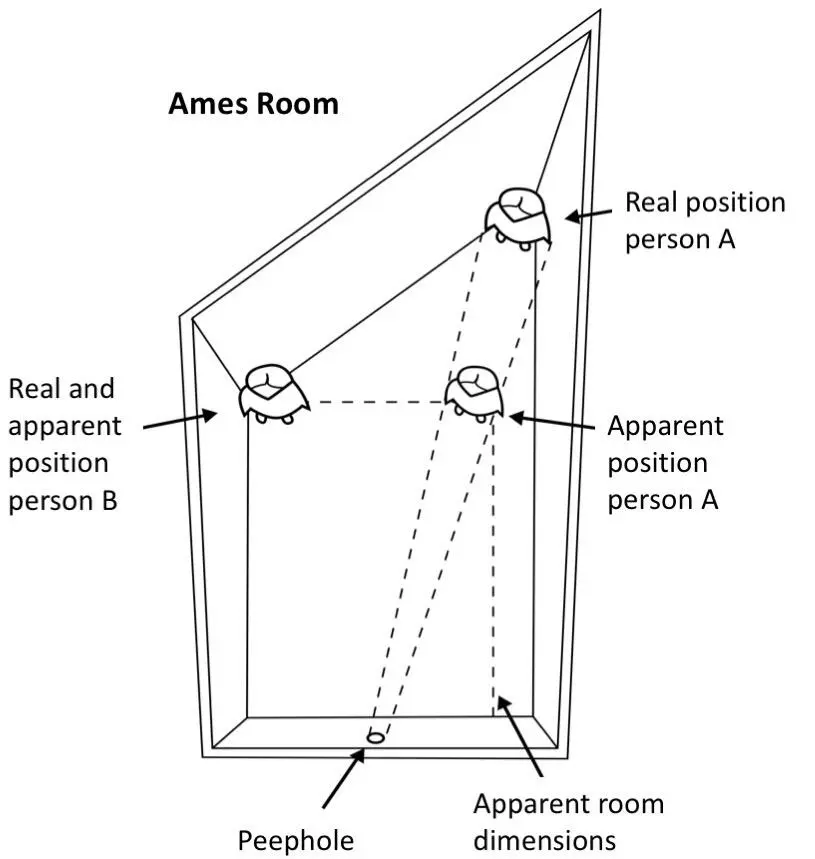
Figure 1.2: Ames Room.
Source: commons.wikimedia.org
Assume the Ames form field hypothesis being set up so that depending on the location of objects in the Ames room those objects grow or shrink physically. The stubborn rectangular box room believer, Mr. S, will now be able to predict correctly what will happen to the ball when it is thrown at the person in the – in reality far-away – corner. The ball will shrink physically.
Incidentally, S should also be able to explain with his theory why the two people throwing the ball to each other do seem not to look entirely straight at each other. If you had not noticed this yet, watch this Ames Room animation [ 2 ]carefully.
In the following chapter we will see what the "Ames Room" and the Ptolemaic world view with our earth in the centre have in common and how they both should warn us about scientific hypotheses that misrepresent reality, while seeming right because of their apparent success. The Ames Room will prove to be an apt metaphor to help us to rethink the many current interpretations of the quantum phenomena so that we can free ourselves from the physics ‘rectangular-box-room’ view when we start a journey of discovery for a valid and meaningful interpretation of quantum physics. We are going to think ‘out of the box’.
2: The discovery of the solar system
“The shape of the heaven is of necessity spherical; for that is the shape most appropriate to its substance and also by nature primary.”
Aristotle, Greek philosopher,
384 BC. – 322 BC.
As a child, you get to know the physical world as stable, solid, and trustworthy. You don’t notice that the earth is a sphere with a radius of almost 6,400 km (4000 mi) doing a complete rotation every day which means that you are spinning with a speed of about 1650 km/h (1025 mph) at the equator and at a somewhat lower speed of 1040 km/h (646 mph) at a latitude of 51 degrees in – say – Amsterdam. You also don’t notice that the earth also revolves around the sun at a speed of about 30 km/s (18 mi/s). These speeds are completely contrary to what you experience standing on the ground, which appears to you to be completely at rest. They are also in contradiction with the experience that tomorrow and the day after tomorrow your home will still be located where it always was. The earth’s gravity which ensures that your feet stay firmly on the ground is so normal and ubiquitous that you probably never realize that you might have a different weight elsewhere. This must have been the experience of ancient man. The earth under his feet at rest and the sun, the moon and the stars reliably revolving through their fixed orbits every day. Even having been educated about our solar system we still say, although knowing better, that the sun rises and sets.
For the ancient farmer, and his clients, it was important for a good harvest to know when to sow and to be able to predict the run of the seasons. The position of the sun, the moon and the stars provided a reliable clock, but before this heavenly clock was usable for predicting it had to be brought into a model fit for arithmetic forecasting. Seafaring man had to be able to navigate by the fixed stars. This is the way the study of the objects in our night sky, astronomy, must have begun. This study of the sky led to the observation that there were stars that had no fixed place in the night sky. They moved with respect to the fixed stars and sometimes they even went back in their own trajectory. Planets or wandering stars they were called, derived from the Greek word planastai: to wander around. Because of their deviant behavior a special meaning became assigned to those wandering stars.
To get an idea of how quantum theory originated and why it is so contrary to how we think our world functions, it will be a good idea to investigate first how our current western image of the universe originated. That western image has a history of at least 24 centuries, so no wonder it has become so naturally self-evident to us. But the question is, is this image correct?
The geocentric Ptolemaic model
Aristotle(384 BC – 322 BC) created one of the first known geocentric models of our universe of the western world. The Greek philosopher conceived a cosmos with the imperfectearth at the centre, surrounded by perfectcelestial bodies, each one attached to its own perfectlycircular revolving transparent sphere. The stars had their home on the most outermost and in approximately 24 hours revolving sphere.

Figure 2.1: Aristotle’s Universe.
Source: Wikimedia Commons.
Down here on imperfect earth all movements were also imperfect, which means they were rectilinear as opposed to the perfect circular movements in the heavens. A cast stone was supposed to travel in a straight line to right above the location where it would fall and then, upon arriving there, supposed to fall straight down. That a keen observation would show otherwise was no problem apparently, people clearly observed what they thought they should see. Phenomena, of which they 'were sure' that could not happen, were not observed. This is a very common human psychological trait. Aristotle’s geocentric model of the cosmos was unsatisfactory, it could not explain the seemingly backwards (retrograde) movement of the planets in their paths through the heavens.
As an echo of things to come, Aristotle also coined the word "hylomorphism", a concept which says that every individual experienced thing is a combination of substance, matter, and form. Form has no material cause but originates from potential. Change and manifestation is caused by the transition from potential to action. With this idea Aristotle seemed already to be on track toward quantum physics, as we shall see.
Hipparchus(about 190 BC – 120 BC) improved on the Aristotelian model by means of epicycles. According to Hipparchus each planet moved in a circular orbit – the epicycle – around a fixed point on its appointed revolving sphere, the deferent. These epicycles explained the erratic retrograde movement. Hipparchus also calculated the distance from the earth to the moon and even to the sun. His achievement was not very far from the mark.
For an idea of the functioning of an epicycle, see figure 2.2. The big circle is the deferent representing the revolving sphere. The arrow indicates the direction of the main revolving movement of the deferent. The small circle in the middle represents the earth. The lesser circle with its centre, a dot, positioned on the deferent is the epicycle. The planet revolves along the epicycle in the direction of the arrow while the centre of the epicycle revolves along the deferent.
Imagine a children's bike wheel with its axis attached to the rim of a normal bicycle wheel. Try then to imagine how the valve of the smaller wheel will move if you set both wheels moving. The valve of the small wheel represents the planet, and the axis of the larger wheel represents the earth. So, if the planet moves from position 2 to 3, it will be, as observed from the earth, seem to be moving backwards. Like sitting in a fairground teacup carousel [1]with sets of three or four teacup gondolas revolving around a centre that in its turn is also revolving around the centre of the carousel. Standing in the middle of the carousel you will see people in the teacup gondolas moving backwards at times. The geocentric cosmos with its epicycles can be seen as a very large carousel with planets as teacup gondolas.
Читать дальше














